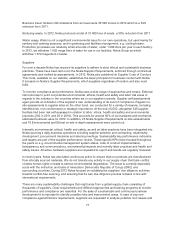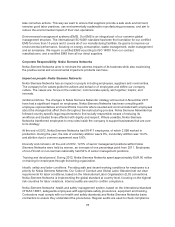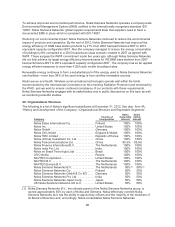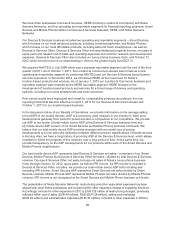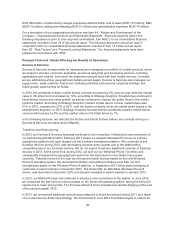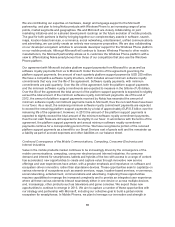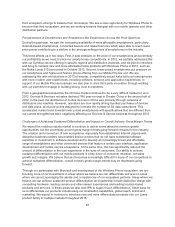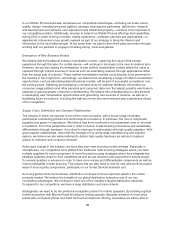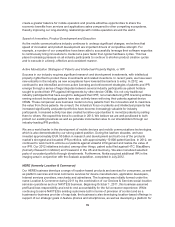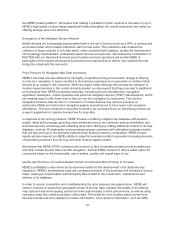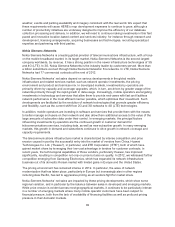Nokia 2012 Annual Report Download - page 88
Download and view the complete annual report
Please find page 88 of the 2012 Nokia annual report below. You can navigate through the pages in the report by either clicking on the pages listed below, or by using the keyword search tool below to find specific information within the annual report.third ecosystem emerge to balance their dominance. We see a clear opportunity for Windows Phone to
become that third ecosystem, and we are working towards that goal with our mobile operator and other
distribution partners.
Pervasiveness of Smartphones and Smartphone-like Experiences Across the Price Spectrum
During the past year, we saw the increasing availability of more affordable smartphones, particularly
Android-based smartphones, connected devices and related services which were able to reach lower
price points contributing to a decline in the average selling prices of smartphones in the industry.
This trend affects us in two ways. First, it puts pressure on the price of our smartphones and potentially
our profitability as we need to price our smartphones competitively. In 2012, we partially addressed this
with our Symbian device offering in specific regions and distribution channels, and we plan to introduce
and bring to markets new and more affordable Nokia products with Windows Phone in 2013, such as
the Nokia Lumia 510 announced in October 2012. Second, lower-priced smartphones put pressure on
our smartphone and higher-end feature phone offering from our Mobile Phones unit. We are
addressing this with introductions in 2013 of smarter, competitively priced Asha full touch smartphones
with more modern user experiences, including software, services and application experiences. In
support of our Mobile Phones business, we also plan to drive third-party innovation through working
with our partners to engage in building strong, local ecosystems.
From a geographical perspective the Chinese market continued to be a very difficult market for us in
2012. Devices & Services net sales declined 78% year-on-year in Greater China in the second half of
2012. In the past, the distribution of mobile devices in China was primarily through networks of
distributors and resellers. However, operators are now rapidly driving bundled purchases of devices
and data plans, all at price points designed to increase the number of 3G data subscribers. This
accelerated market trend towards lower-priced smartphones with specifications that are different from
our current strengths has been negatively affecting our Devices & Service business throughout 2012.
Challenges of Achieving Sustained Differentiation and Impact on Overall Industry Gross Margin Trends
We expect the mobile products market to continue to deliver some attractive revenue growth
opportunities, but the uncertainty around gross margin trends going forward remains for the industry.
The creation and momentum of new ecosystems, especially from established Internet players with
disruptive business models, has enabled device vendors that do not have substantial software
expertise or investment in software development to develop an increasingly broad and affordable
range of smartphones and other connected devices that feature a certain user interface, application
development and mobile service ecosystems. At the same time, this has significantly reduced the
amount of differentiation in the user experience in the eyes of consumers. Our ability to achieve
sustained differentiation with our mobile products is a key driver of consumer retention, net sales
growth and margins. We believe that as it becomes increasingly difficult for many of our competitors to
achieve sustained differentiation, overall industry gross margin trends may be depressed going
forward.
Through our partnership with Microsoft and development of the Windows Phone ecosystem, we are
focusing more of our investments in areas where we believe we can differentiate and less on areas
where we cannot, leveraging the assets and competencies of our ecosystem partners. Areas where we
believe we can achieve sustained product differentiation and leadership include distinctive design with
compelling hardware, leading camera and other sensor experiences and leading location-based
products and services, in these areas we also hold IPR to support such differentiation. Other ways for
us to differentiate our products include using our localization capabilities, global reach, brand and
marketing. We expect to continue to introduce new and more differentiated products into our Lumia
product family in multiple markets throughout 2013.
87


